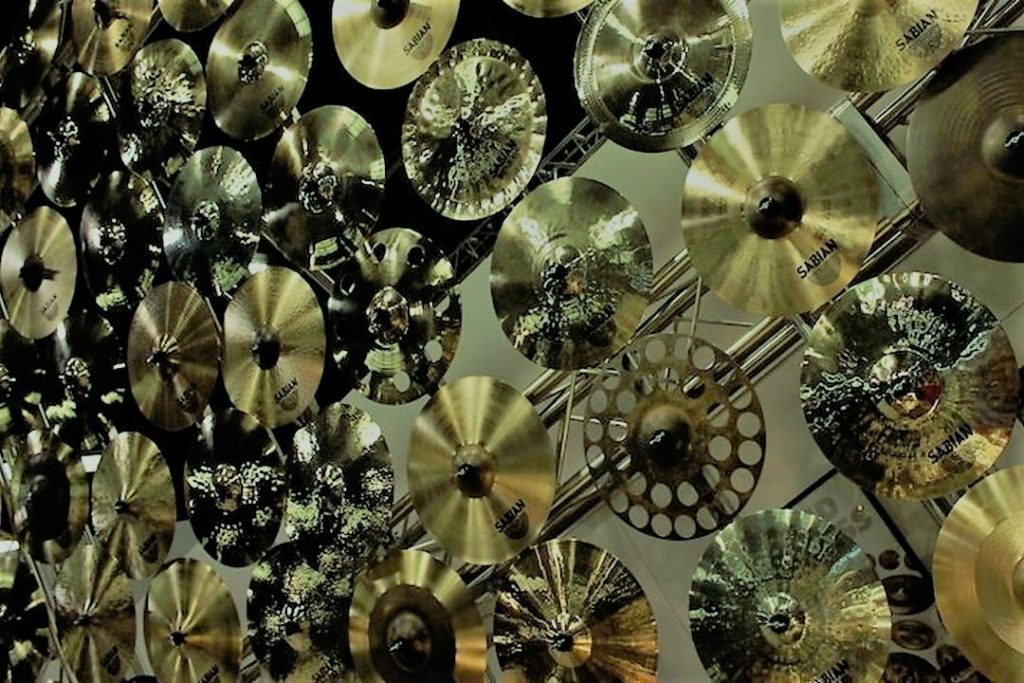It’s difficult for a beginner to tell the difference between all the different types of cymbals.
When you think you’ve seen them all, you notice a new type of cymbal on some YouTuber’s drum set and wonder, “What the hell is that?”
That is why I am convinced that everyone should learn as much as possible about the fundamentals of a new hobby in order to make the process of learning that hobby easier.
When it comes to drumming, this entails mastering techniques such as:
- Different types of drums;
- Different types of cymbals;
- How to set up a drum set;
- Different types of sticks;
- Different types of hardware;
- How to properly hold a drum stick;
- The correct posture for a drummer;
- Etc.
Learning to play the drums should be a priority only after you’ve mastered the fundamentals; otherwise, the learning process will be unnecessarily difficult.
With that in mind, let’s learn a little about the various types of cymbals:
What’s a cymbal?
A cymbal is a percussion instrument that is circular and concave and is made of metal alloys such as brass or bronze.
They make entry-level cymbals out of brass or a bronze alloy like B8 (8% tin, 92% copper), while high-end cymbals are mostly made out of B20 bronze (20% tin, 80% copper).
Some cymbal manufacturers, such as Paiste, make high-end cymbals out of a bronze alloy ranging from B8 to B20, and they’re quite successful.
A cymbal is played by striking it with a drumstick, your hands, or even in pairs (Hi-Hat, for example).
They’re an important part of any drum set, and their sizes range from 4″ accents to 30″ rides (though sizes larger than 24″ are uncommon).
Cymbals come in a variety of sizes and shapes, as you’ll see later in the article, and each one has its own sound and purpose.
Let’s talk about the different parts of a cymbal before we get into the different types of cymbals:
The anatomy of a cymbal
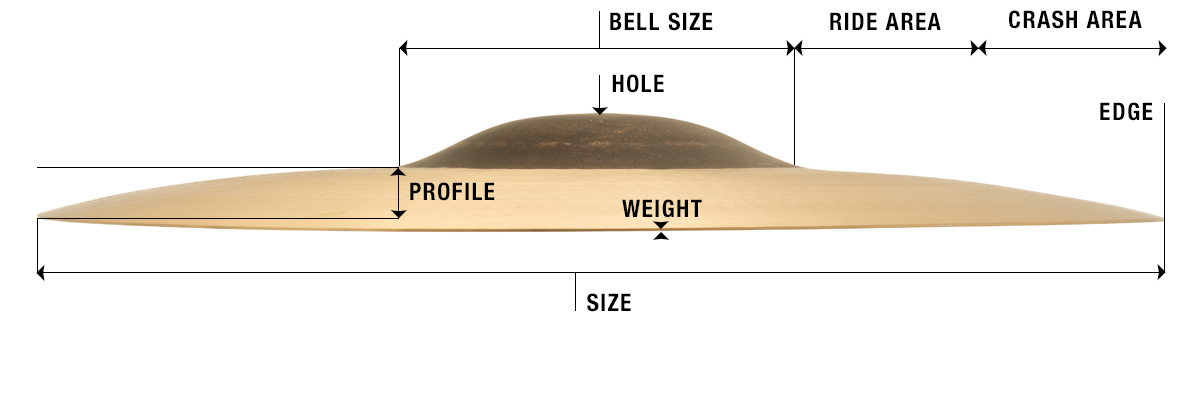 Every cymbal has a hole in the center that is used to attach it to a cymbal stand.
Every cymbal has a hole in the center that is used to attach it to a cymbal stand.
A bell, which looks like a bump in the middle of the cymbal, surrounds the hole. Because it has a higher pitch than the rest of the cymbal, it can be used for accents.
The bell plays a significant role in a cymbal’s overall sound, as the larger it is, the more overtones it produces, as well as the greater its projection and volume are.
The circumference of the cymbal is its edge, and you crash it near the edge because it’s usually thinner than the rest of the cymbal (otherwise it wouldn’t be “crashable”).
On that note, the edge of a cymbal is its most delicate part, so before you start cracking cymbals left and right, make sure you learn the proper striking technique.
The bow is the area between the bell and the edge. The ride area refers to that curved area. It’s the perfect spot for more complex patterns. A more curved bow has a higher pitch and a faster attack, whereas a less curved bow has the opposite effect.
Weight, thickness, and diameter of a cymbal are three other factors to consider. The lighter and thinner the cymbal, the faster it decays, the fuller the overall sound, and the lower the volume.
The diameter of a cymbal also affects its sound, with larger cymbals having a lower pitch and more projection, while smaller cymbals have the opposite effect.
Sheet Cymbals vs Cast Cymbals
High-end cymbals begin as molten bronze alloy, which is then poured into a mold or cast to produce a rough shape resembling a cymbal, as we’ve seen before.
The disc is “bell pressed,” hammered by machine or by hand and cut in the second part of the process, resulting in what we commonly refer to as an unfinished cymbal.
The lathing and polishing are the final steps in this traditional cymbal-making process, at least when the cymbal has a brilliant finish.
Lathing is not only a way to define how a cymbal sounds by leveling out the ridges and grooves, which changes the cymbal’s attack and wash, but it’s also a way to reduce the thickness of a cymbal.
Finally, cymbal finishes are typically brilliant or traditional, also known as a natural finish. Traditional cymbals are darker than cymbals with a brilliant finish because they do not go through the polishing process.
A brilliant finish cymbal, on the other hand, goes through one final step in which it is polished and a special coat is applied to protect it from dirt and rust.
However, there’s more…
Entry-level cymbals, on the other hand, are machine stamped from rolled metal sheets, which is a much faster and less expensive cymbal-making process.
That isn’t to say that every cast cymbal is of professional quality, or that sheet cymbals are always entry-level instruments; both methods have advantages and disadvantages.
Sheet cymbals still require casting, but it is usually done by an outsider, and the manufacturer simply cuts the cymbals from a large sheet of metal.
As I previously stated, both processes have advantages and disadvantages, with cast cymbals typically sounding better, being more durable, and producing a richer and more complex sound. Furthermore, no two cymbals sound alike, and they are much more expensive.
Sheet cymbals are the polar opposite: they sound worse than cast cymbals, are less durable, and have little to no variation between models despite being cheaper to produce.
Because there is no right or wrong answer, deciding between cast and sheet cymbals is a matter of personal preference.
Types of Cymbal Finishes
As we’ve seen, cymbal finishes are typically divided into two categories: brilliant and traditional.
As the name implies, a cymbal with a traditional finish, also known as natural, has a dull surface.
When compared to the same cymbal with a brilliant finish, the raw, un-lathed surface produces a darker tone.
Brilliant finish cymbals, on the other hand, are the polar opposite in terms of appearance and sound. They have a gleaming surface that adds to the cymbal’s brightness.
Additionally, they go through an additional process that smoothes out the grooves and defines the sound of the cymbal, so keep that in mind when selecting your next cymbal.
When it comes to choosing a cymbal finish, it’s important to remember that there’s no right or wrong answer because neither option is better than the other. It’s all a matter of personal taste.
How are cymbals made?
If you want to see how cymbals are made, here’s a short video from Zildjian, one of the world’s largest cymbal manufacturers, that shows the whole process:
How many types of cymbals are there?
It’s difficult to say how many different types of cymbals there are because some cymbals can easily fall into two categories.
A crash/ride, for example, is neither a crash nor a ride. They’re usually a thick enough crash to be used as a ride, or a thin enough ride to be “crashable.”
Plus, they’re not particularly well-known these days, so do they really deserve their own category? Adding them to the crash or ride category, depending on their size, is the most logical choice.
In any case, the following are the most common types of cymbals found in a drum kit:
Hi-Hat Cymbals
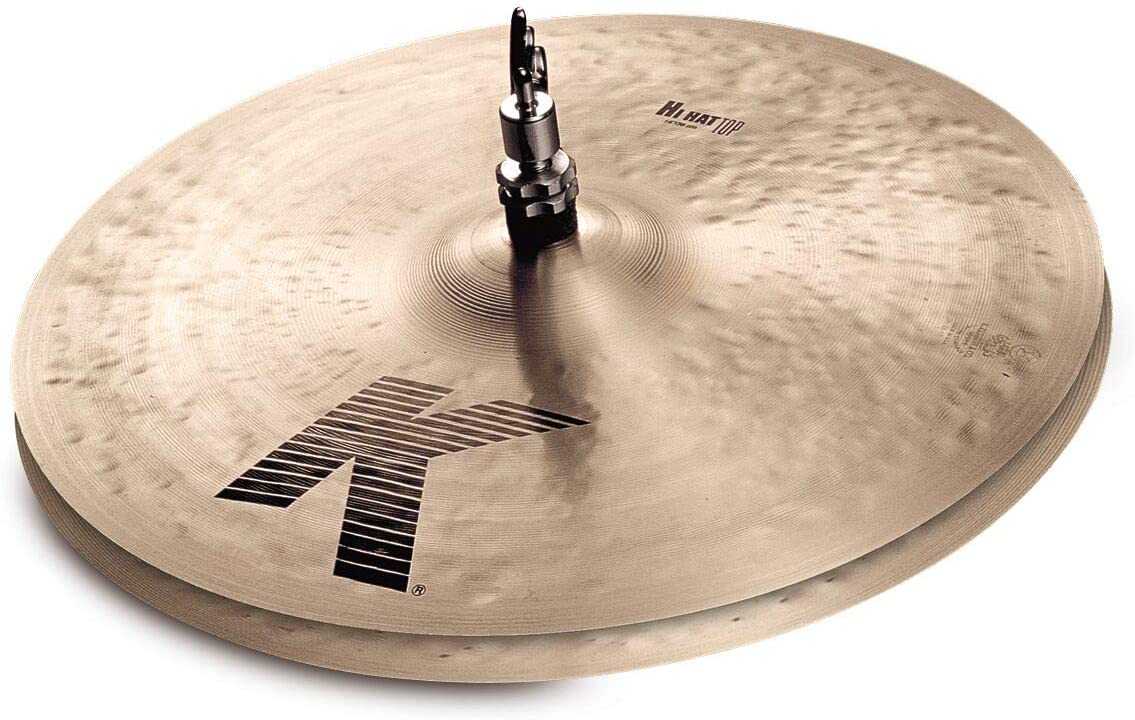
The Hi-Hat, out of all the different types of cymbals, is probably the most important and is found in every drum kit.
It plays plays an important role in timekeeping as one of the essential elements of a groove, which is why it’s so important for a drummer.
The Hi-Hat is different from other cymbals in that it is sold in pairs, with a top and bottom cymbal.
You don’t want to switch up the bottom cymbal because it’s thicker and heavier. At least one of them is clearly labeled, so you won’t have any trouble figuring out which one is which.
Furthermore, the average Hi-Hat is 14″ in diameter, but there are a few Hi-Hats with diameters ranging from 8″ to 18″ that are less popular.
Hi-Hat cymbals are also distinguished by the fact that they are mounted on a Hi-Hat stand rather than a standard cymbal stand.
The bottom cymbal is attached to the Hi-Hat stand, while the top cymbal is connected to the Hi-Hat rod via a Hi-Hat clutch.
That way, you can adjust the Hi-Hat position using the foot pedal on the Hi-Hat stand, whether it’s open, closed, or somewhere in between.
The Hi-Hat produces a short and crisp sound known as “chick” when struck closed or with the foot pedal.
When you slowly release your foot, you’ll hear a variety of trashy sounds that can come in handy in certain situations.
Ride Cymbals
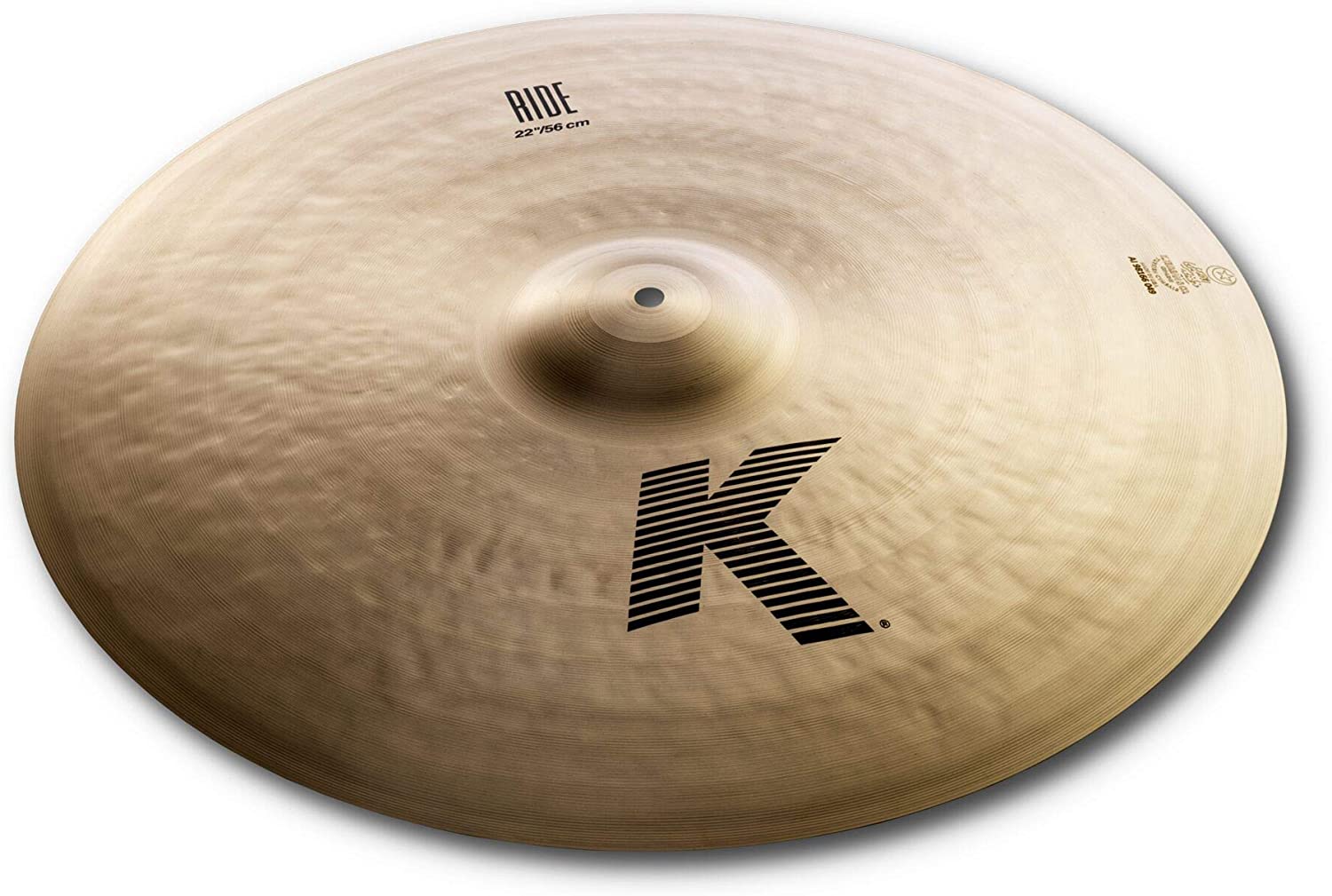
The ride cymbal isn’t as important as the Hi-Hat, and some drummers don’t even use it.
On the other hand, it’s still the centerpiece of any jazz drum kit and can be found in the majority of drum kits around the world.
It serves a similar purpose to the Hi-Hat in that it is primarily used in grooves and to maintain a consistent rhythmic pattern.
They’re also likely the largest cymbal in a drum set, with the smallest ride measuring 18″ in diameter.
Some cymbal manufacturers, such as Stagg, produce ridiculously large Rides, such as their 30″ super ride model, but the average Ride is less than 26″ in diameter.
Furthermore, despite the fact that it resembles a larger crash cymbal (more on that later), a Ride is played entirely differently, unless it’s a crash/ride.
A Ride is mostly played on the bow with the tip of a drumstick or the bell with the drumstick’s shoulder, whereas a crash is often struck on the edge to deliver a loud and explosive sound.
This produces a clear, articulate “ping” with a long sustain, making it an excellent instrument to use in your grooves.
A Ride cymbal is usually the most expensive cymbal in a drum kit due to its average size.
Crash Cymbals
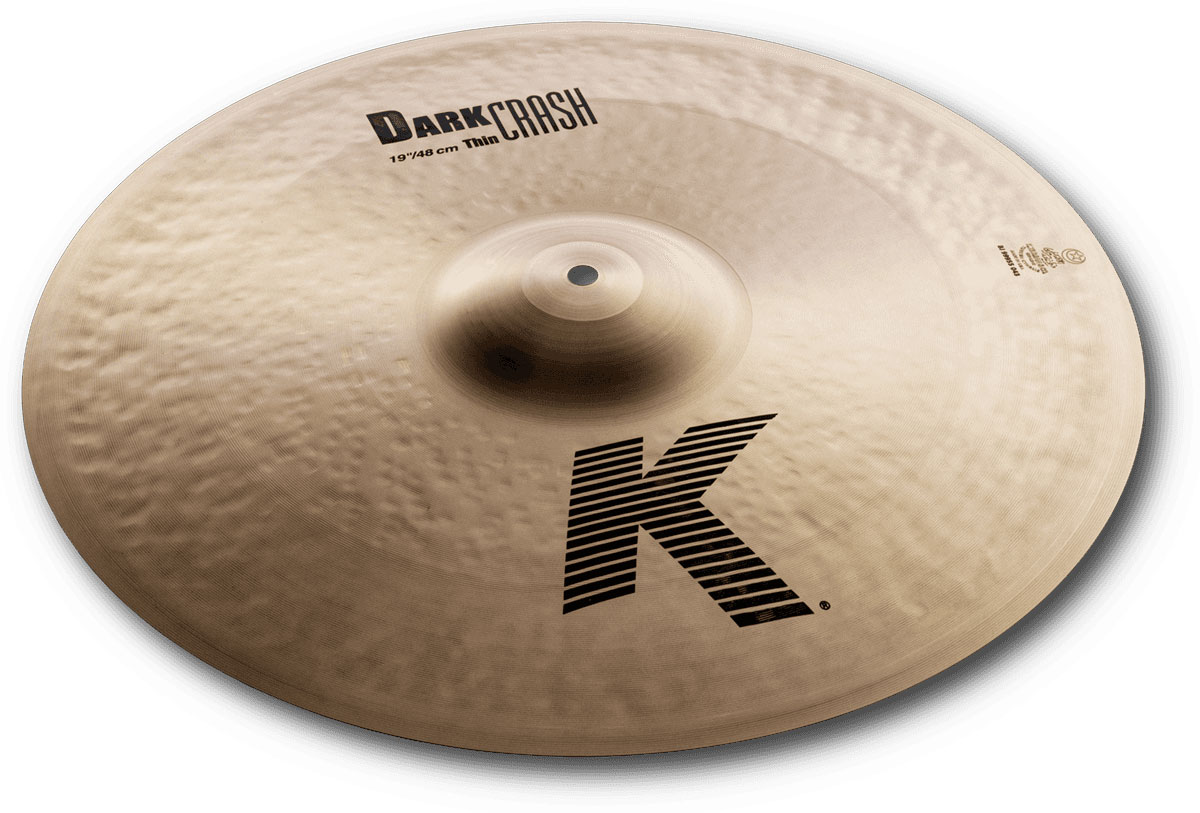
The sound of a crash cymbal is what most people imagine when they think of a cymbal.
Although they’re usually found in a traditional drum kit, some drummers prefer to use crash/rides or crashable thin rides instead.
Any crash cymbal must be at least 14″ in diameter; any smaller and we’re talking about splash cymbals, which we’ll discuss next.
They can also be as large as 26″, but at that size, it’s more of a crash/ride than anything else. The average crash cymbal is between 16″ and 20″ in diameter, with some exceptions.
They’re typically played by striking them on the edge to produce a loud and explosive crashing sound that cuts through anything, as we’ve seen before.
The crash cymbal is frequently used at the end of a drum fill or as a transition between music sections, while the hi-hat and ride cymbals are used as timekeepers.
Furthermore, they come in a variety of thicknesses, with thinner crashes producing a lighter tone and thicker crashes being preferred by rock and metal drummers.
They’re also the most commonly used cymbals on a drum set, with most drummers using two to three crash cymbals at any given time.
Splash Cymbals
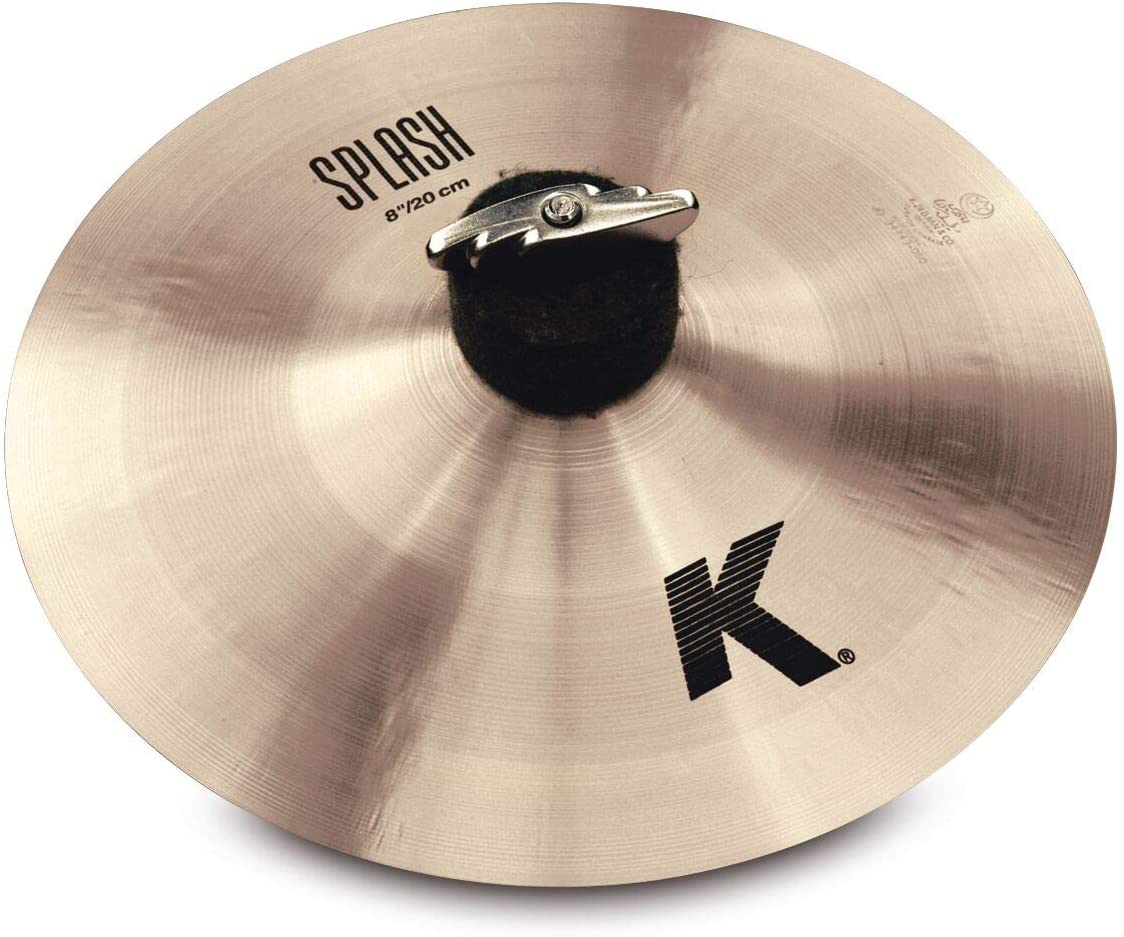
Splash cymbals stand out from the rest because they are the smallest cymbals on a drum set.
They come in a variety of sizes ranging from 6″ to 13″, including odd sizes, but the most popular sizes are 6″ and 8″.
They also produce a quick and bright sound with a very short decay time. As a result, you’ll have a great cymbal to accent your drum fills or spice up your grooves.
Splash cymbals are the cheapest cymbals available, and they’re also a lot of fun to use in your grooves and fills.
Besides that, their small size makes them incredibly simple to arrange in any configuration, regardless of how many drums and cymbals you have.
Furthermore, some drummers use them to change the tone of a drum, particularly snare drums.
When you hit the snare drum, it makes a loud crack, similar to how a sampled snare sounds. Since you’re only limited by your imagination, striking the splash itself is also an option.
Splash cymbals are often mistaken for effects cymbals, but given their popularity, I believe it’s only fair to put them in their own category.
China Cymbals

China Cymbals got their name from the fact that they look and sound like a traditional Chinese gong. Their easily identifiable inverted cymbal edges set them apart from the rest.
China cymbals, like splash cymbals, are frequently classified as effects cymbals.
Considering how popular they are, especially in heavier music genres like rock and metal, are distinct enough to justify their own category.
They’re loud and explosive, just like crash cymbals, but they’re a lot more aggressive and trashier.
The average diameter of a china cymbal is between 14 and 24 inches, but there are a few unpopular models with diameters as large as 27 inches.
There’s also the “mini china cymbal,” which has a diameter of 8″ to 13″ and is commonly referred to as such.
Because they’re not as loud as a regular china, consider them a cross between a china and a splash, or a trashy splash cymbal.
You can use them as a single accent or as a hi-hat or ride substitute to keep time in heavier music genres when using them on a traditional drum kit.
Wanna know more about the best china cymbals on the market? HERE‘s my article on the subject.
Stack Cymbals
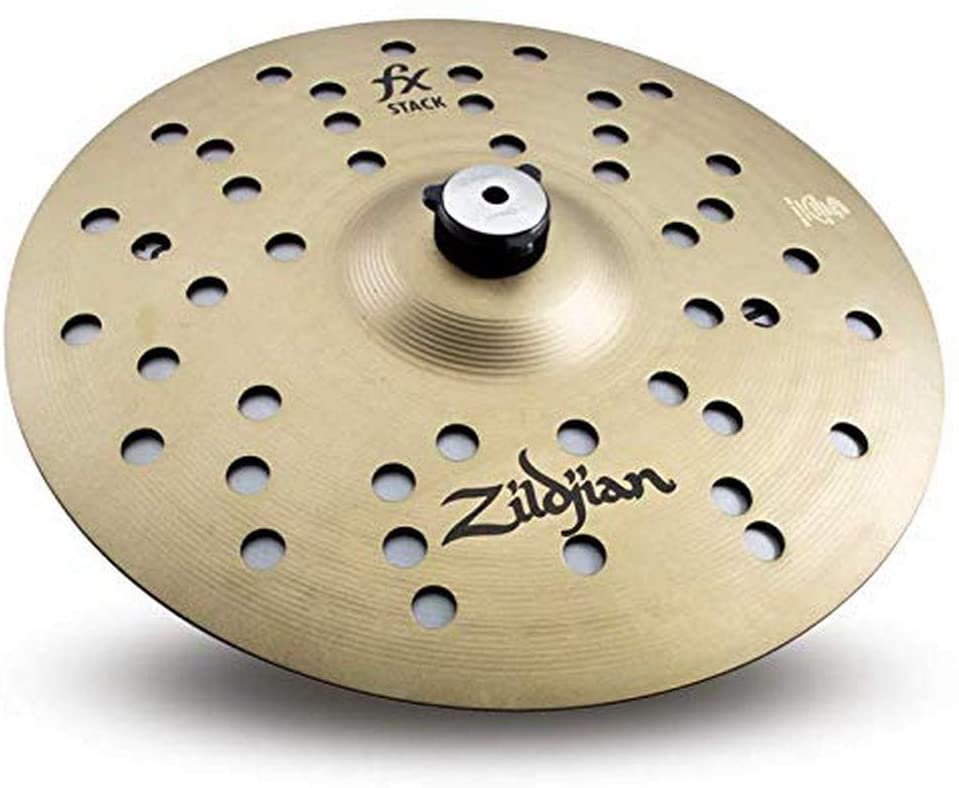
A cymbal stack is simply two or more cymbals stacked on top of each other, as the name implies.
Stacks have become increasingly popular in recent years, and they are probably my favorite type of cymbal.
They’re extremely versatile, as you can make a stack out of almost any pair of cymbals as long as the bells and bows have the same curvature.
On that note, you can mix and match a splash and a mini china, a crash and a china, two splashes, two crashes, a crash and a splash, and whatever else comes to mind.
There is no limit to how many cymbals you can stack when it comes to cymbal stacks. One of the most popular cymbal stacks in the world, the clap stack, combines 3 to 5 cymbals and works surprisingly well.
Additionally, because flaws don’t affect a stack as much and sometimes even make it trashier, you can make a stack out of old, cracked cymbals that would otherwise be useless.
Most brands sell pre-packed cymbal stacks if you don’t have any cracked cymbals or none of your cymbal combinations sound good.
The benefit of purchasing a pre-packed cymbal stack is that it will sound good right out of the box and will fit together well.
Stacks, like china cymbals, are excellent for accenting grooves and fills, as well as driving a groove.
Wanna know more about the best cymbal stacks on the market? HERE‘s my article on the subject.
Bell Cymbals
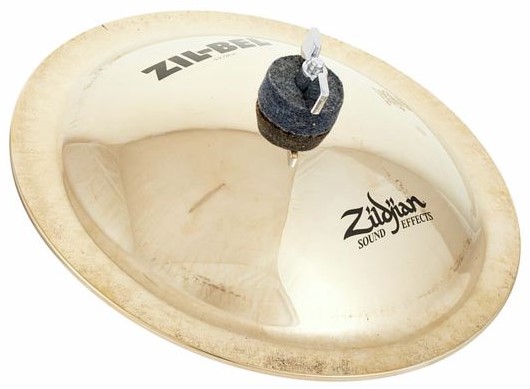
Bells, out of all the different types of cymbals available, are probably the least popular.
They’re a bell with a diameter of 4 to 13 inches and little to no taper, as the name implies. The most popular models range in size from 6″ to 10″.
They sound like a bell struck by a drumstick, with a loud, high-pitched tone and long sustain.
Because they’re small and don’t get used as often as other cymbals, they’re usually stacked on top of another one to save space.
Furthermore, they’re particularly well-liked in the metal community for accentuating drum fills.
Effects Cymbals
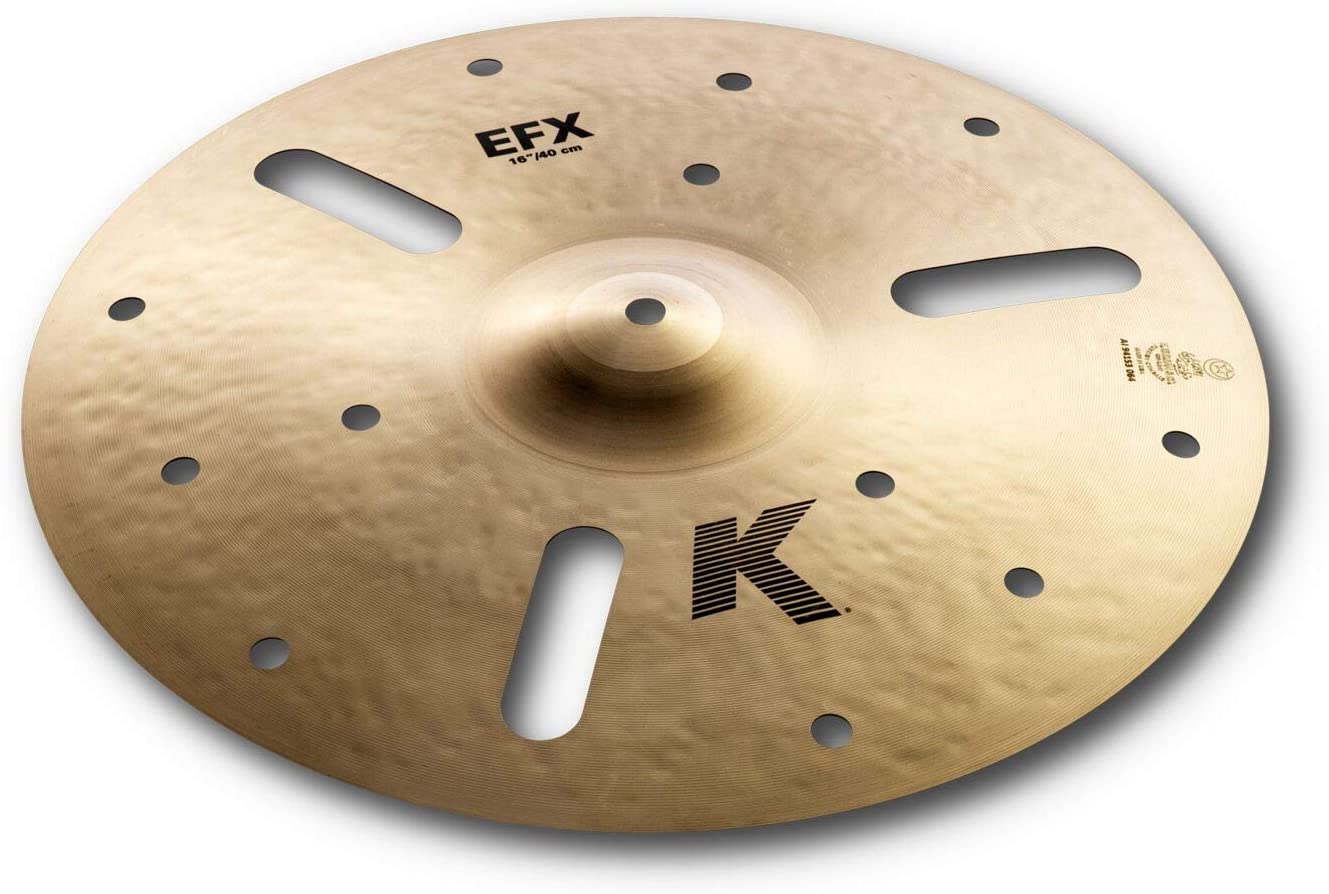
Unlike the others, the term “effects cymbals” is a broader category that encompasses a wide range of cymbals.
Aside from cymbal stacks, some of my favorite cymbals are effects cymbals, which are typically just a variation of a traditional cymbal.
Crash, china, and splash cymbals with holes drilled to increase trashiness and shorten the decay are some of the most popular effects cymbals.
Effects cymbals include accent cymbals, which are small cymbals shaped like a bell, and spiral stackers, which are stacked on top of a cymbal to increase the trashiness of the bottom cymbal while lowering its sustain.
Splash, bell, stack, and china cymbals are also excellent examples of effects cymbals, but they have their own category due to their popularity.
To summarize, an effects cymbal is anything that isn’t a traditional Hi-Hat, Crash, or Ride cymbal, or something that adds a unique twist to a standard cymbal.
Honorable Mentions
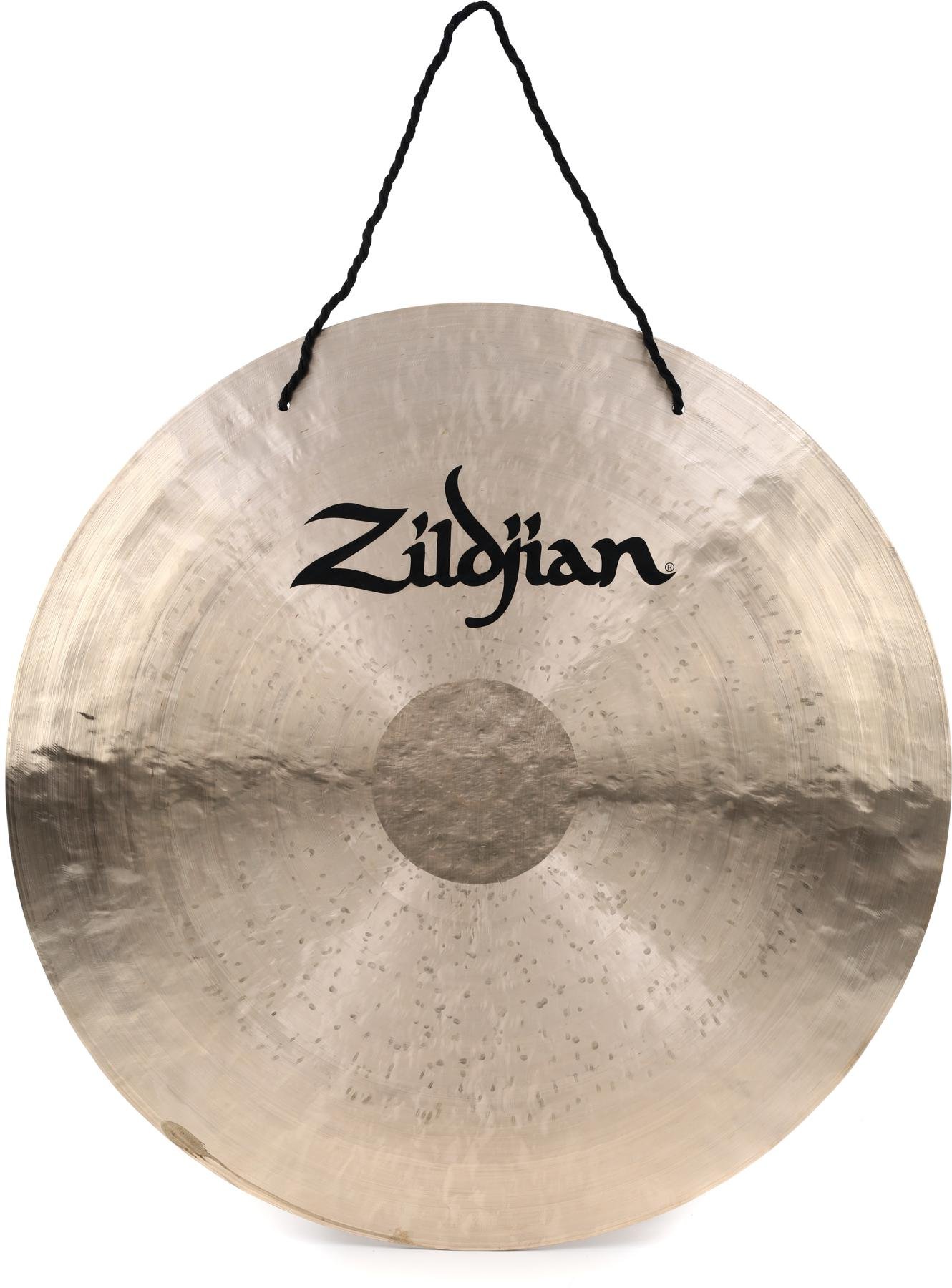 Gongs
Gongs
Even if it’s unlikely to see a drummer playing a Gong on stage, I’m confident that the average person can recognize what a Gong looks like.
They’re often used in gameshows, Hollywood movies and sometimes in a symphony orchestra, so for the average drummer, they’re pretty useless despite being easily recognizable.
Furthermore, unlike traditional cymbals, they are usually played with a mallet and are suspended rather than placed on a cymbal stand.
Gongs come in a variety of sizes, ranging from 20″ to 60″ in diameter on average. They’re also made of bronze, the most common of which is B22.
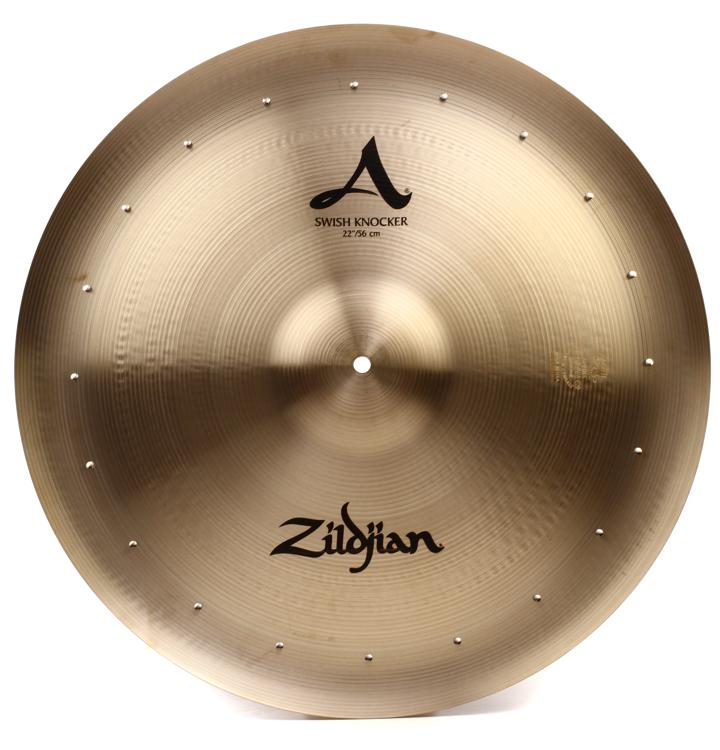 Sizzle Cymbals
Sizzle Cymbals
These cymbals are simply traditional cymbals with rivets, chains, or any other type of rattles added to alter the original sound.
Those additions reduce the cymbal’s sustain while increasing its original “wash,” so it’s just another cymbal variation.
Rivets or chains can be added to any cymbal, but the ride cymbal is probably the most common application.
Sizzle cymbals aren’t as well-known as they once were, and most people have probably never heard of them.
Regardless, I believe they are deserving of at least an honorable mention.
Hand / Finger Cymbals
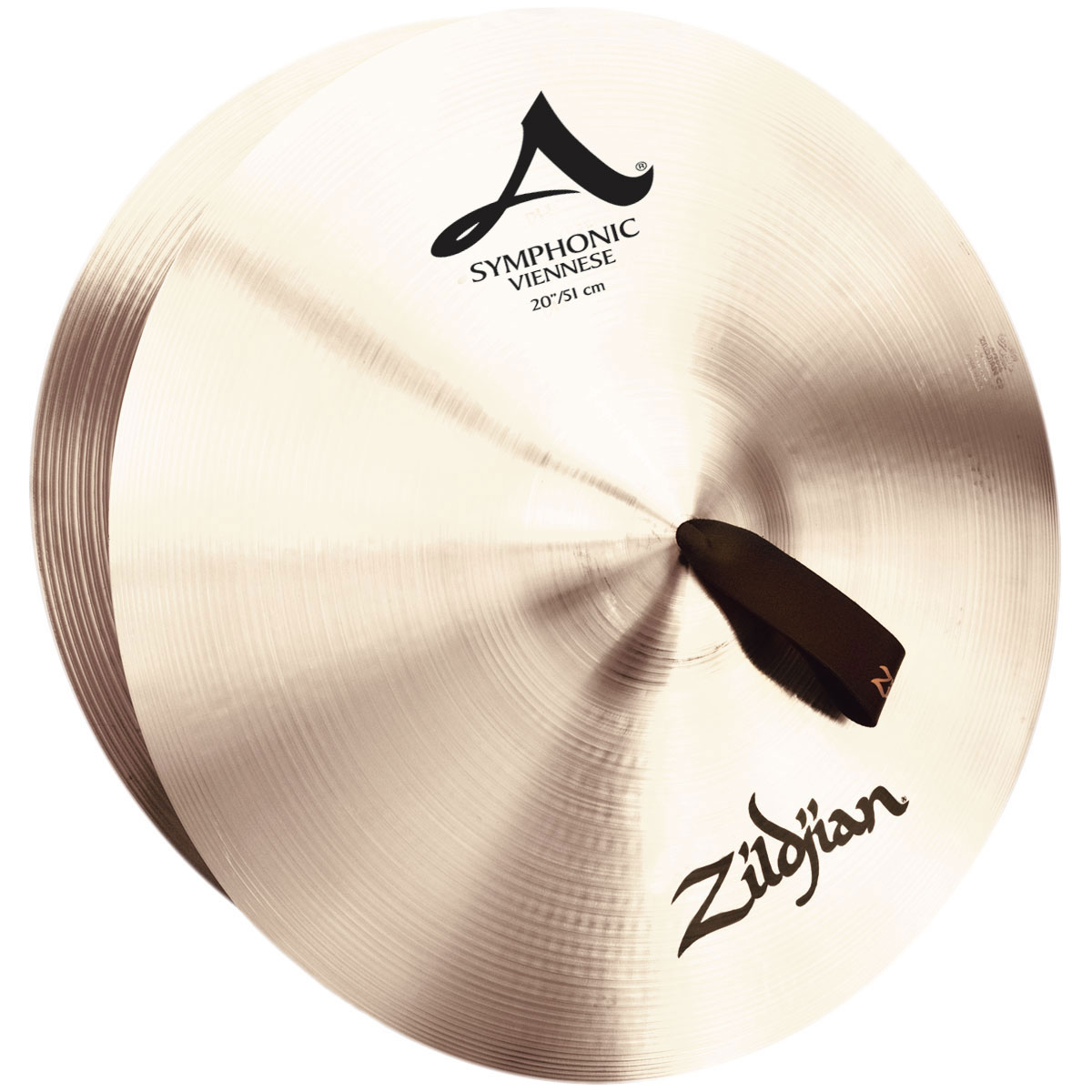
Despite the fact that they’re just as useless as a Gong for the average drummer, their history makes them worthy of mention.
Hand cymbals, also known as clash cymbals or concert cymbals, are percussion instruments that can be found in marching bands, orchestras, and other percussion ensembles.
They’re played in pairs, and one is held in each hand. Instead of using a drumstick to strike them, they are struck against each other.
Furthermore, their size typically ranges from 14″ to 22″ and they are held in place by a strap in the bell.
Moreover, finger cymbals, also known as zills, are cymbals that are similar to those found on a traditional tambourine.
To be honest, they’re useless for drummers, but belly dancers and other similar performers frequently use them.
They’re played with a pair of cymbals on each hand, and each cymbal comes with an elastic to keep it on your finger.
They make zills out of brass, which is the same material used in entry-level cymbals, unlike high-end cymbals.
Conclusion
There are many different types of cymbals, as you probably already know, but if you’re a beginner looking to buy your first set, you should know that some are far more important than others.
At the very least, you should focus on getting a decent ride, hi-hat, and crash cymbal. Purchasing a cymbal pack would be a wise decision because you get more for your money.
If you’re looking for the best budget cymbal pack, HERE‘s my article on the subject. Alternatively, HERE‘s one about low volume cymbals.
These are the cymbals that every drummer uses the most, making them the most important.
Splash and china cymbals, as well as cymbal stacks, are not as important and should be considered a luxury.
Don’t get me wrong: they’re a lot of fun to play, but if you don’t know the basics of drumming, there’s no point in getting into effects cymbals.
Anyway, I hope this article was helpful in informing you about the different types of cymbals, and if you have any questions, please send me an email and I’ll gladly respond.

